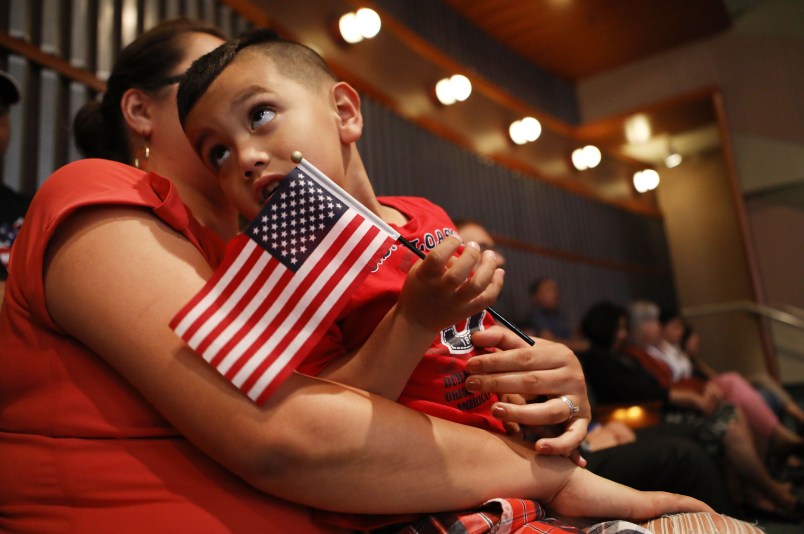In the wake of a federal judge slapping down the Trump administration’s attempt to roll back decades-old protections for children in immigration detention, the Trump administration is threatening to present migrant parents with a choice between indefinite detention with their children or continued separation — leaving out the third option used by previous administrations of supervised release.
“The court does appear to acknowledge that parents who cross the border will not be released and must choose between remaining in family custody with their children pending immigration proceedings or requesting separation from their children so the child may be placed with a sponsor,” Justice Department spokesman Devin O’Malley said in a statement Monday night.
The Trump administration argued unsuccessfully in a California federal court that they should be allowed to modify the Flores settlement — a 1997 ruling upheld in 2016 that states that immigrants younger than 18 years old can’t be held in immigration custody for longer than 20 days. It also set standards for the food, medical care and other conditions of their detention, saying the government can’t hold children in facilities that can’t pass state child welfare licensing regulations.
Without revealing whether or not the administration plans to appeal the ruling to the Ninth Circuit Court of Appeals, O’Malley said: “We disagree with the court’s ruling declining to amend the Flores Agreement to recognize the current crisis of families making the dangerous and unlawful journey across our southern border.”
But the fiery Monday night ruling from U.S. District Court Judge Dolly Gee did not give the administration the green light for indefinite detention and separations the DOJ is claiming.
In fact, she wrote that even if there were an immigration “crisis” as the administration claims — an assertion not supported by data — this “does not support a blanket non-release policy.” She later added that “absolutely nothing prevents Defendants from reconsidering their current blanket policy of family detention and reinstating prosecutorial discretion” — referring to past administrations’ policy of allowing the majority of immigrant families who are not considered a danger or a flight risk to be freed on supervised released until their immigration or asylum hearings.
Gee also shot down the administration’s argument that it is forced to indefinitely detain the families throughout their immigration proceedings, which could take months or years, because “families frequently fail to appear” in court when released.
“Executive Office of Immigration Review data shows that between 2001 and 2016, 86 percent of family detainees attended all of their court hearings,” she wrote. “The evidentiary record is unclear as to the accuracy of Defendants’ assertion.”
Gee also took a dim view of the Trump administration’s claim that her ruling upholding the Flores settlement in 2015, when the Obama administration was attempting to implement a form of long-term family detention, was responsible for a surge in illegal immigration.
The administration had tried to argue in court that the ruling spurred more parents to cross the border with their children “because it led arriving families to believe that Defendants would rather release them than separate the children from their families.”
The data on border crossings in the intervening years, Judge Gee shot back, “do not establish that the Court’s July 24, 2015 Order in any way caused this ‘surge.’ Defendants’ reasoning suffers from the ‘logical fallacy of post hoc, ergo propter hoc.’ Literally, ‘after this, therefore because of this.'” It is much more likely, she added, that the uptick in Central American migration was caused by “civil strife, economic degradation, and fear of death in the migrants’ home countries.” The underwhelming evidence the administration presented, she concluded, had “failed to show that detaining families would deter future illegal border crossings.”
Still, President Trump doubled down Tuesday morning on the idea of the family separations as a deterrent to immigration, saying the message of the policy was “We have laws. We have borders. Don’t come to our country illegally.”







More cases referring to this doomed regime as “Defendants,” please.
DOJ Threatens More Migrant Family Separations After Judge’s Scathing Ruling
Just another day of doubling down on the inhumanity.
The Republican’t Response: How dare you not allow us to make shit up!
I want to buy this judge dinner. Such a relief to have a reality-based opinion from someone in a position of power.
More deliberate cruelty from trump’s minions at DoJ. And from cnn.com there is a story of a 91 yr old man being beaten with a brick. His crime? Being Mexican in the country legally and taking a walk in his son’s neighborhood.
There’s blood on trump’s hands